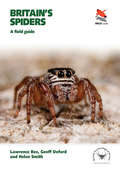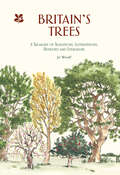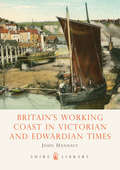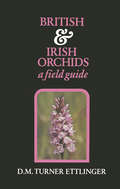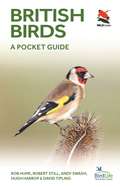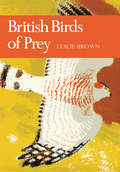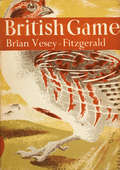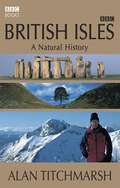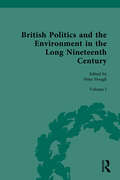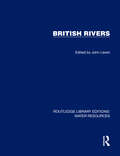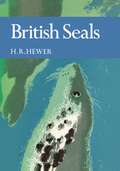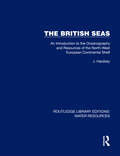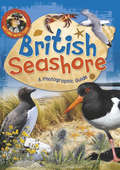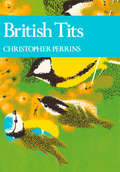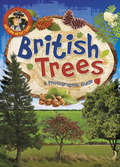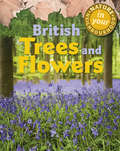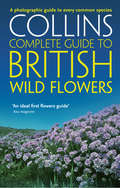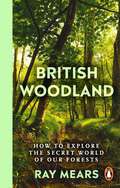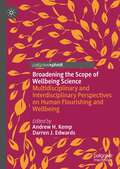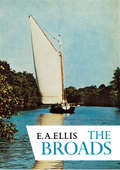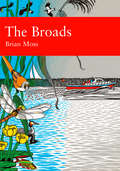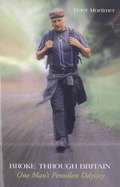- Table View
- List View
Britain's Spiders: A Field Guide (PDF)
by Lawrence Bee Geoff Oxford Helen SmithBritain’s Spiders is a photographic guide to all 37 of the British families, focussing on spiders that can be identified in the field. Illustrated with a remarkable collection of photographs, it is designed to be accessible to a wide audience, including those new to spider identification. This book pushes the boundaries of field identification for this challenging group by combining information on features that can be seen with the naked eye or a hand lens with additional evidence from webs, egg-sacs, behaviour, phenology, habitats and distributions. Individual accounts cover 395 of Britain’s approximately 670 species, with the limitations to field identification clearly explained. As the first photographic field guide to British spiders to be published since 1989, this book fills a major gap in the resources available to everyone with an interest in this fascinating, diverse and important group of animals. More than 700 stunning photographs Includes a guide to spider families, based on features recognisable in the field, focussing on body shape and other characteristics, as well as separate guides to webs and egg-sacs Detailed accounts highlight key identification tips for each genus and species, and include information on status, behaviour and habitats Features up-to-date distribution maps, and charts showing adult seasonality Introductory chapters explore the biology of spiders, and where, when and how to find them, including equipment needed in the field Contains a complete list of the spiders recorded in Britain, indicating the ease of identification as well as rarity and conservation status Provides information on how to record spiders and make your records count, and guidance on how to take your interest further
Britain's Trees: A Treasury Of Traditions, Superstitions, Remedies And Literature
by Jo Woolf National Trust BooksA cornucopia of some of Britain's oldest and most beloved native trees, this book weaves together their rich history, folklore and traditions.
Britain's Working Coast in Victorian and Edwardian Times (Shire Library #548)
by John HannavyThe coastline of Victorian and Edwardian Britain provided beauty, entertainment and the venue for most people's holidays. But it was also a thriving centre of industry shipbuilding and fishing, plus the numerous trades associated with dockyards, coastal transport and the leisure industry. This book travels around Britain's coast clockwise from London looking at the industries that could be found at many of the cities and towns en route. Illustrated with an amazing collection of coloured postcards and other early photographs, the working coast of Britain is brought to life in all its bustling detail.
British Birds: A Pocket Guide (Wildguides Ser. #30)
by Rob Hume Robert Still Andy Swash Hugh Harrop David TiplingA carefully designed and lavishly illustrated photographic guideThis innovative and carefully designed photographic guide provides a concise introduction to the identification of the 246 birds most likely to be seen in Great Britain and Ireland. It is the perfect book for anyone wanting to put a name to the birds in their garden, local area or on visits farther afield. Packed with hundreds of stunning photos showing the birds in their many variations, and written and designed by a team of experienced birdwatchers, this is the ideal companion for anyone interested in learning more about the wild birds around us.Covers the 246 birds most likely to be seen, plus another 30 or so scarce but regular migrantsCarefully designed to be user-friendly and accessibleLavishly illustrated with more than 1,000 stunning colour photographsEasy to use and written in plain English
British Birds of Prey (Collins New Naturalist Library #60)
by Leslie. H. BrownLeslie Brown's account of our 15 resident, 7 vagrant and 2 migrant species of eagles, falcons, hawks and vultures in Britain presents a great mass of scientific information about our birds of prey in a manner as attractive to the general reader as to the dedicated ornithologist.
British Game (Collins New Naturalist Library #2)
by Brian Vesey-FitzgeraldBritish Game ranges beyond the strict legal interpretation of game and is full of interesting details about the birds and beasts that should interest sportsmen. This edition is exclusive to newnaturalists.com
British Isles: A Natural History
by Alan TitchmarshAccompanying a major new BBC1 series presented by Alan Titchmarsh, British Isles: A Natural History is a fascinating journey through the natural history of Britain from its birth to the present day. Written in Alans uniquely readable style, the book chronicles the different periods in Britain's evolution, exploring everything from the geology and geography to the flora and fauna that make up the diverse landscapes of the British Isles. It also includes a gazetteer section detailing where you can explore for yourself Britain's natural treasures. Beautifully illustrated with 180 colour photographs, it will appeal to natural history enthusiasts and everyone who cares about the country they live in. The book contains the latest research gathered in the making of this new landmark series from the BBC's NHU in Bristol. Alan Titchmarsh is a bestselling BBC author and has sold over a million copies of his books which include How To Be A Gardener 1 and 2 and Royal Gardeners.
British Politics and the Environment in the Long Nineteenth Century: Volume I - Discovering Nature and Romanticizing Nature
by Peter HoughThis volume of archival source material chronicles British environmental politics between 1789 and 1914. This text examines scientific discoveries during this period and the result of these findings on the political environment, bringing the public's attention to public health issues such as acid rain and river pollution. Accompanied by extensive editorial commentary, this collection will be of great interest to students of environmental and political history.
British Politics and the Environment in the Long Nineteenth Century: Volume I - Discovering Nature and Romanticizing Nature
by Peter HoughThis volume of archival source material chronicles British environmental politics between 1789 and 1914. This text examines scientific discoveries during this period and the result of these findings on the political environment, bringing the public's attention to public health issues such as acid rain and river pollution. Accompanied by extensive editorial commentary, this collection will be of great interest to students of environmental and political history.
British Rivers (Routledge Library Editions: Water Resources)
by John LewinOriginally published in 1981, this book describes and interprets the physical nature of British rivers and is authored by leading authors from universities, the Institute of Hydrology and a water Authority. The contents include data on river regimes and catchment characteristics, information on water quality in both polluted and unpolluted rivers, a full discussion of river channels and their erosion and sediment characteristics, and a consideration of river management problems in the distinctive British context. Where possible, nationwide information is presented in map form and many of the maps presented a national picture for the first time. The book will be of interest to students and scientists in a wide range of disciplines: geography, geology, environmental science, hydrology and engineering. Those professionally engaged in environmental management and the water industry should also find it useful. In summary, all who are concerned with rivers – as agents of landscape change, sedimenting phenomena, environmental resources or flood hazards will find this book as relevant now as when it was first published.
British Rivers (Routledge Library Editions: Water Resources)
Originally published in 1981, this book describes and interprets the physical nature of British rivers and is authored by leading authors from universities, the Institute of Hydrology and a water Authority. The contents include data on river regimes and catchment characteristics, information on water quality in both polluted and unpolluted rivers, a full discussion of river channels and their erosion and sediment characteristics, and a consideration of river management problems in the distinctive British context. Where possible, nationwide information is presented in map form and many of the maps presented a national picture for the first time. The book will be of interest to students and scientists in a wide range of disciplines: geography, geology, environmental science, hydrology and engineering. Those professionally engaged in environmental management and the water industry should also find it useful. In summary, all who are concerned with rivers – as agents of landscape change, sedimenting phenomena, environmental resources or flood hazards will find this book as relevant now as when it was first published.
British Seals (Collins New Naturalist Library #57)
by H. R. HewerA comprehensive account of the seal’s migratory patterns, methods of hunting and patterns of reproduction.
The British Seas: An Introduction to the Oceanography and Resources of the North-West European Continental Shelf (Routledge Library Editions: Water Resources)
by Jack HardistyOriginally published in 1990 and designed as a student text, The British Seas is a clear introduction to the oceanography and resources of the region. It is unique in providing a detailed review of the resources of the north-west European continental shelf together with a comprehensive description of the environment. Introducing the shelf region as if it were a new country, Jack Hardisty explores first its physical environment and then summarizes the distribution and exploitation of resources from the environment. Part 1 – on the oceanography - covers the shape of the shelf, its geological history and its wave and tidal regimes. Part 2 – on the resources – looks at trade and shipping, and the hydrocarbon, fishing and seabed mining industries. It goes on to discuss wave and tidal power, and to consider the problem of pollution in terms of resource utilization. The industrial technology and the environmental potential of each resource are examined, and the economic and legislative restrictions are analysed.
The British Seas: An Introduction to the Oceanography and Resources of the North-West European Continental Shelf (Routledge Library Editions: Water Resources)
by Jack HardistyOriginally published in 1990 and designed as a student text, The British Seas is a clear introduction to the oceanography and resources of the region. It is unique in providing a detailed review of the resources of the north-west European continental shelf together with a comprehensive description of the environment. Introducing the shelf region as if it were a new country, Jack Hardisty explores first its physical environment and then summarizes the distribution and exploitation of resources from the environment. Part 1 – on the oceanography - covers the shape of the shelf, its geological history and its wave and tidal regimes. Part 2 – on the resources – looks at trade and shipping, and the hydrocarbon, fishing and seabed mining industries. It goes on to discuss wave and tidal power, and to consider the problem of pollution in terms of resource utilization. The industrial technology and the environmental potential of each resource are examined, and the economic and legislative restrictions are analysed.
British Seashore: Seashore (Nature Detective #5)
by Victoria MunsonFind out about the most common plants, insects, crustaceans, seasweeds, molluscs and birds found on British seashores today. Full descriptions of each, along with their scientific name, size, family and food. Beautiful, large colour photographs will make identification easy. Includes fascinating information about rock pools, the tides, food chains and safety at the beach.From shells and anemones, to jellyfish and crabs, lugworms, urchins, sandhoppers, butterflies and gulls, a world of wildlife waits for you to discover it. Become a nature detective and explore the natural world around you. If you enjoy this book, then why not search out the other titles in this series: British Birds; British Mammals; British Trees; British Wild Flowers and British Insects.
British Tits (Collins New Naturalist Library #62)
by Christopher PerrinsIn addition to dealing with the general biology and behaviour of the birds, Dr Perrins gives full attention to such things as their social lives, their intelligence and adaptiveness, and their puzzling ability to adjust their population sizes to the future availability of food. This edition is exclusive to newnaturalists.com
British Trees: Trees (library Ebook) (Nature Detective #3)
by Victoria MunsonFind out about more than 50 of the most common trees found in Britain today. Full descriptions of the trees, along with their scientific name, size, family and habitat, will ensure you can recognise which tree is which. Beautiful large colour photographs of the trees, their leaves, seeds and fruits, will help with easy identification. Includes information about broadleaved trees and conifers, explaining the difference between deciduous trees and evergreens, and looks at how the parts of trees, from the leaves and bark to seeds and berries, can help you to recognise each tree.You can also follow a step-by-step activity to help you create your own tree guide. Become a nature detective and explore the natural world around you. If you enjoy this book, then why not search out the other titles in this series: British Birds; British Mammals; British Insects; British Wild Flowers and British Seashore.Features the following trees: English Oak, Turkey Oak, Sessile Oak, Aspen, White Willow, Weeping Willow, Pussy Willow, Crack Willow, Common Osier, Black Poplar, White Poplar, Silver Birch, Alder, Hazel, Hornbeam, Common Beech, Common Ash, Elder, Holly, Common Lime, Large-leave Lime, Small-leaved Lime, London Plane, Rowan, Horse Chestnut, Sweet Chestnut, Field Maple, Sycamore, Yew, Wych Elm, English Elm, Whitebeam, Hawthorn, Blackthorn, Crab Apple, Wild Cherry, Common Pear, Common Juniper, Walnut, Magnolia, Norway Spruce, Larch, Douglas Fir, Scots Pine, Sitka Spruce, Cedar, Monkey Puzzle Tree.
British Trees and Flowers (Nature in Your Neighbourhood #4)
by Clare CollinsonFrom magnificent oaks to delicate bluebells, there are a whole host of trees and flowers to discover in Britain. Learn all about the extraordinary range of trees and wild flowers that grow in British neighbourhoods. Find out where to look for different species, how to identify them and much more.The book is part of the 'Nature in your neighbourhood' series - find out all about the plants and animals that live all around you!
British Wild Flowers: A Photographic Guide To Every Common Species (Collins Complete Guide)
by Paul SterryA complete photoguide to all the wild flowers of Britain.
British Woodland: How to explore the secret world of our forests
by Ray MearsNobody sees and understands woodland better than Ray Mears.With deep natural history knowledge and practical woodcraft skills, gained over a lifetime of learning from the world's last remaining indigenous peoples, Ray offers a different way to experience our wooded landscapes. He challenges the old concepts. He looks to our ancestors and shows how man's hand in shaping woodland is critical. We are not separate from nature, we just need to ensure that our interactions have a positive impact.With the emphasis on interaction, British Woodland is structured by usage. We learn that sycamore and clematis are among the best woods for burning, pine and oak help us navigate, and hawthorn and beech have edible leaves. Rope can be made from willow, utensils and tools from hazel, and historically, weapons were made from yew and wych elm.With Ray as our guide, encouraging this sense of connection to individual trees, our appreciation of wooded landscapes will change. We can learn how to live inclusively in nature, for our own wellbeing and enjoyment, and also for the future of our planet.
Broadening the Scope of Wellbeing Science: Multidisciplinary and Interdisciplinary Perspectives on Human Flourishing and Wellbeing
by Andrew H. Kemp Darren J. EdwardsThis book brings together leading researchers on wellbeing science to provide a multidisciplinary approach to psychological wellbeing with implications for the interconnected societal challenges we face today, including loneliness, neoliberalism, inequality and anthropogenic climate change. Its authors present new and innovative models for understanding, building and improving our understanding of the complex construct of wellbeing. The capacity for individual positive change is explored, as well as the scope for such change to impact on the communities and environments within which we live. Further, the book places individual wellbeing within a broader context that also addresses societal needs and challenges. In doing so, it provides a novel synthesis of individual, societal and environmental perspectives on wellbeing and human flourishing.In the face of an urgent need to build stronger, sustainable and more resilient communities, this book demonstrates how wellbeing science can link the individual with the community through appropriate health and wellbeing policies and offers a guide to a new way for individuals to connect with the world. It will appeal to researchers and professionals working across the fields of psychology, environmental science, public health and public policy.
The Broads (Collins New Naturalist Library #46)
by A. E. EllisThe Broads discusses the history of the Broads, the people who come into contact with and influence these waterways, and what the future holds.
The Broads (Collins New Naturalist Library #89)
by Brian MossThe Broads discusses the history of the Broads, the waters in the past and the waters now, the people who come into contact with and influence these waterways, and what the future holds for this small but important area of the countryside. This edition is exclusive to newnaturalists.com
Broke Through Britain: One Man's Penniless Odyssey
by Peter MortimerDuring the summer of 1998, Peter Mortimer set off on the 500-mile journey from Plymouth to Edinburgh, accompanied only by his King Charles spaniel. He took no money and had no transport or pre-arranged accommodation. Bereft of the basics necessary for human existence, such as food and shelter, he was dependent for his survival on his own wits, the generosity of others and good fortune.
